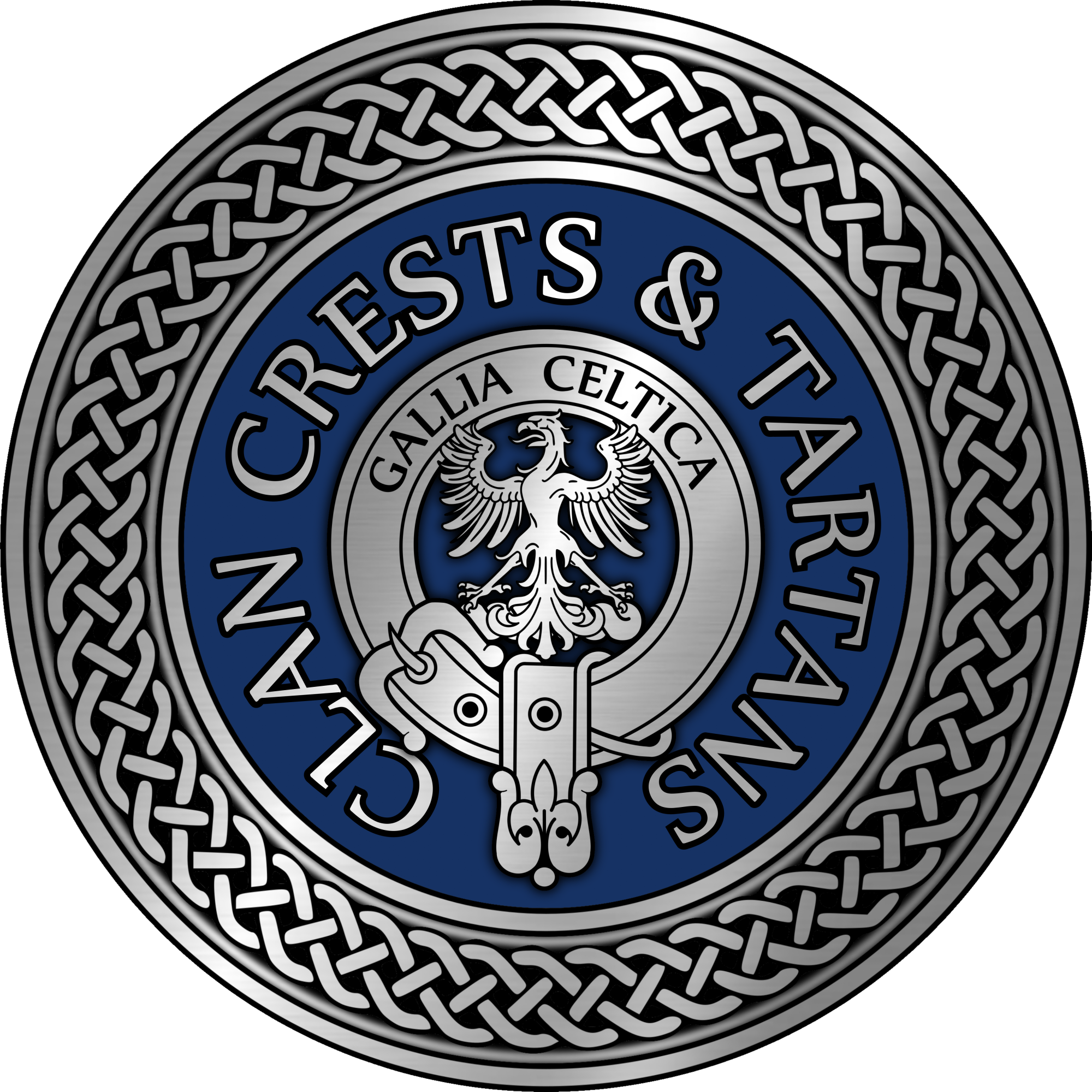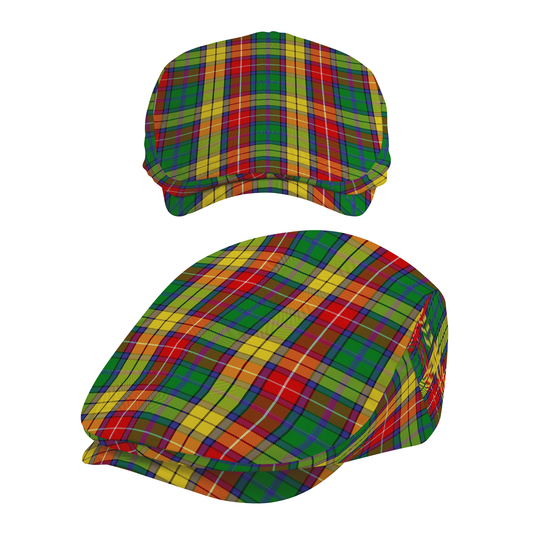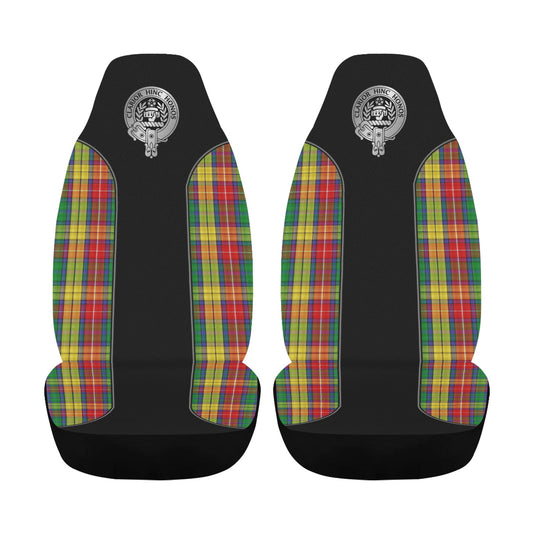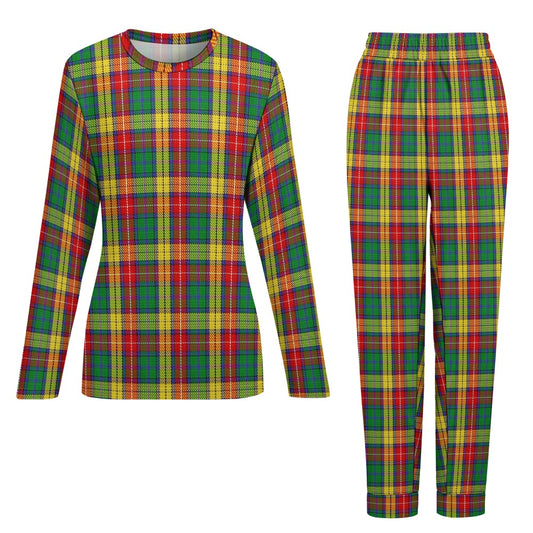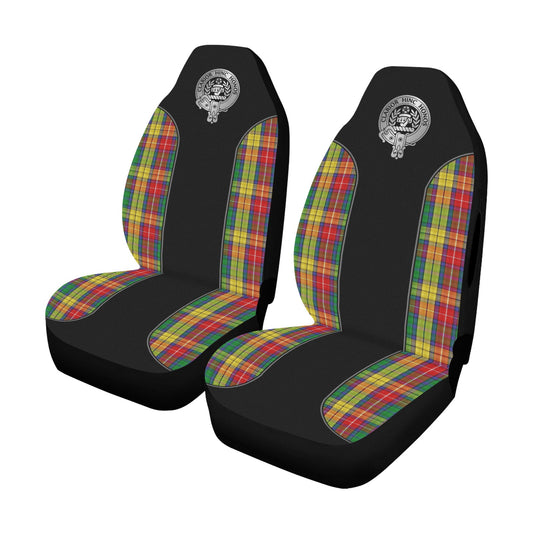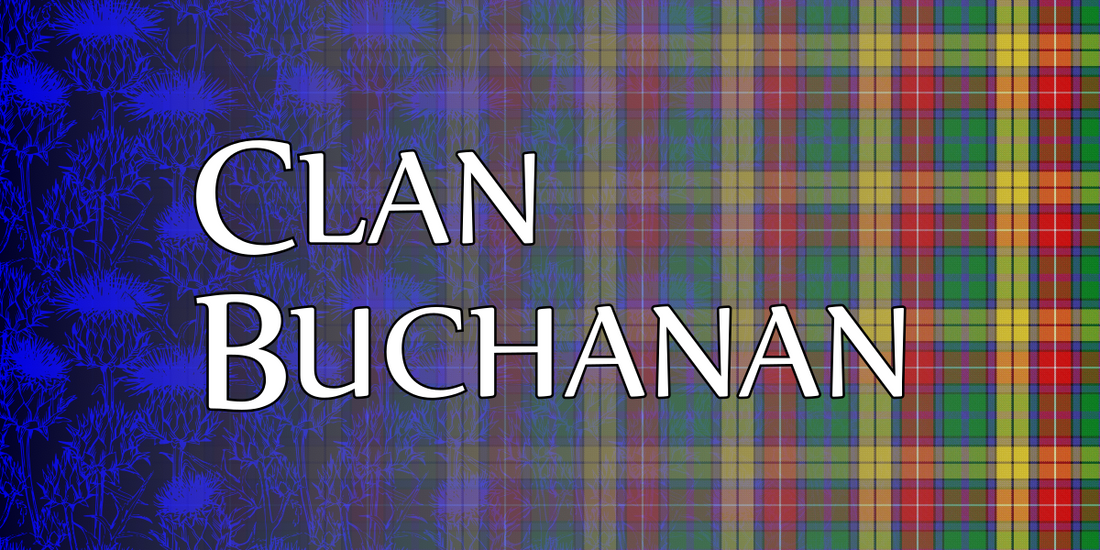

Scots Gaelic: Na Cananaich
Clan Buchanan is a Highlands Scottish Clan whose origins are said to lie in the 1225 grant of lands on the eastern shore of Loch Lomond to clergyman Sir Absalon of Buchanan by the Earl of Lennox.
Profile
Crest: A hand coupee holding a ducal cap, or duke's cornet, proper, with two laurel branches wreathed surrounding the crest, disposed orleways proper.
Motto: Clarior hinc honos "The Brighter Hence the Honour" or "Henceforth forward the honour shall grow ever brighter"
Slogan: Clar Innes
Plant Badge: Rock Ivy
Region: Highlands
District: Stirling
Pipe Music: "The Return of the Chief" by Richard Harris, 2016
Historic Seat: Buchanan Auld House and Clairinch island
Seat: Cambusmore
Chief: John Michael Baillie-Hamilton Buchanan of that Ilk, The Buchanan
Clan Relationships
Branches
Auchneven, Leny, Arnprior, Spittall, Auchmar
Septs
Bohanan, Bohanon, Bohannan, Bohannon, Buchannan, Buchannon, Buchanon, Buxton, Colman, Cormack, Cousland, Dewar, Dove, Dow, Dowe, Gibb, Gibbon, Gibson, Gilbert, Gilbertson, Harper, Harperson, Leavy, Lennie, Lenny, MacAldonich, MacAlman, MacAslan, MacAslin, MacAuselan, MacAuslan, MacAusland, MacAuslane, MacAlman, MacAlmont, MacAmmond, MacAsland, MacChruiter, MacColman, MacCormack, MacCubbin, MacCubbing, MacCubin, MacGeorge, MacGibbon, MacGreuisich, MacGubbin, MacInally, MacIndeor, MacIndoe, MacKinlay, MacKinley, MacMaster, MacMaurice, MacMurchie, MacMurchy, MacNeur, MacNuir, MacNuyer, MacQuattie, MacWattie, MacWherter, MacWhirter, Masters, Masterson, MacCaslin, Morrice, Morris, Morrison, Murchie, Murchison, Richardson, Risk, Rusk, Ruskin, Spittal, Spittel, Walter, Walters, Wason, Waters, Watson, Watt, Watters, Weir, Yuill, Yool, Yule, Zuill.
Allied Clans
Campbell, Graham
Rivals
MacLaren
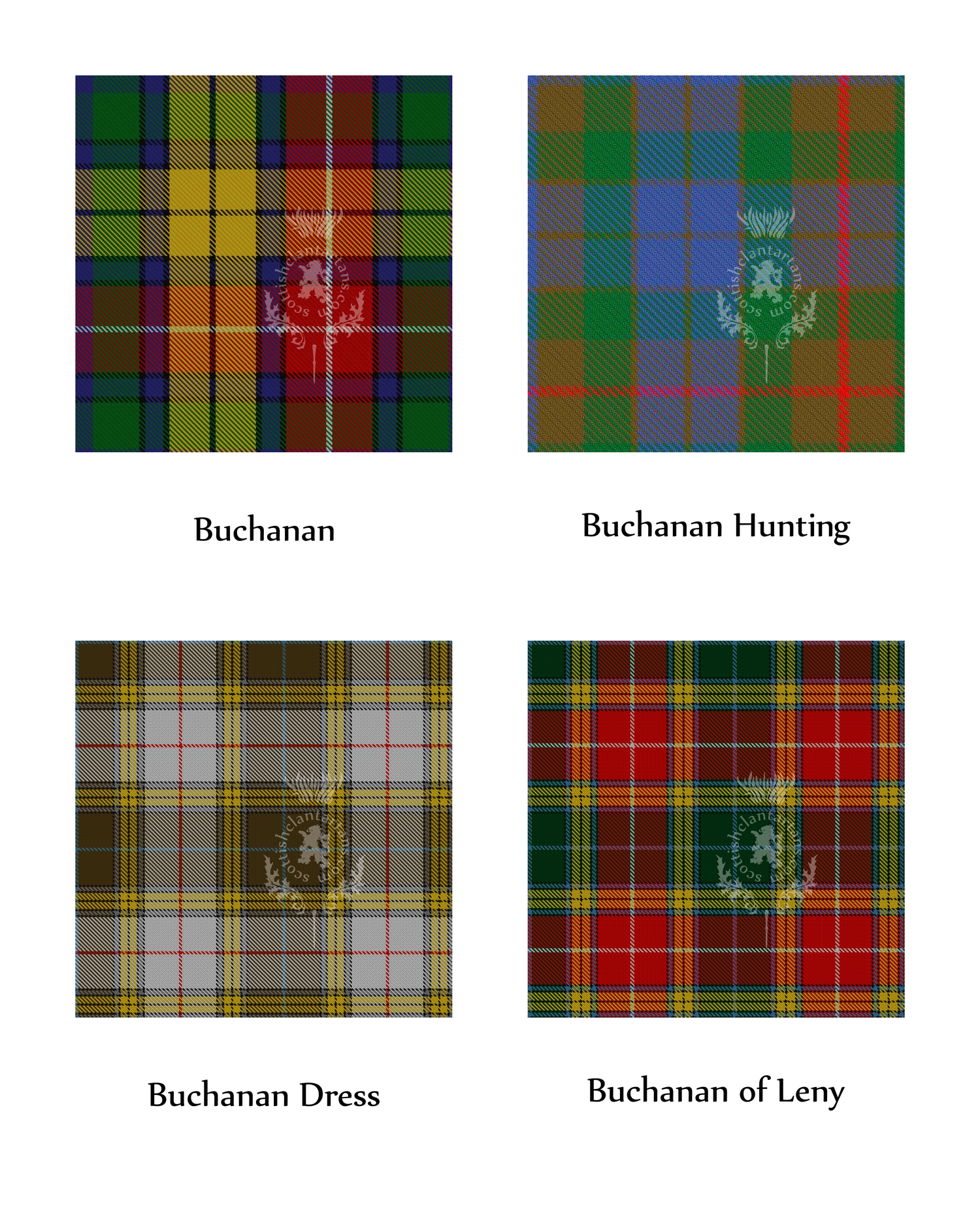
Clan Tartans
Shop Buchanan TartansClan History
The name is said to derive from Macauselan (meaning son of Anselan). The following two names are given as the root of the territorial name Buchanan, Mac a Chanonaich (The Son of the Canon) and Buth Chanain (meaning house or seat of the canon).
Traditionally, the clan's origin myth traced the chiefly line back to Anselan O Kyan, who was of the Irish clan Ó Catháin, a provincial king of north Ulster (and had his seat in Limavady, County Londonderry). He is said to have landed in Argyll in 1016. According to this tradition, for his services against the Danes he received from king Malcolm II the lands of Buchanan, which lie to the east of Loch Lomond around the village of Killearn.
During the reign of Malduin, Mormaer (Earl) of Lennox, 1217–1250, Anselan (third of that name) was granted, in 1225, the island of Clairinch. (Clár Inis). He is referred to as 'clericus meus', meaning 'my clergyman'. He is subsequently recorded as Absalom de Buchanan and it is understood that to have this title, there must have been other grants of land in the parish of Buchanan. During the reign of King Alexander II (1214–1249), Gilbert de Buchanan, seneschal to the Earl of Lennox, received, in 1231, a charter confirming Clareinch (or Clairinch) and other lands in Buchanan. It is from the lands of Buchanan that the Clan name is derived.
However, the traditional accounts of the origin of the clan, the land and name derivation in Scotland are inconsistent with other historical accounts for the previous period in Ireland, as well as the data from the extensive DNA project, and is officially considered to be little more than origin myth.
Further proving this account as only myth, a special meeting was held on 23 January 2021 for the Council of the Clan Buchanan Society International (CBSI), wherein Clan President, David Byrne, informed all present members, "...that origin myth has been in our history books and in our tents forever. Auchmar, in his history of the clan, was the one who really pushed that forward ... and it's the one everyone has clung to. It is a great story. The problem is that it's not accurate. It didn't happen. From the yDNA Project, run by Ross Buchanan (in Ireland) and Alex Buchanan (in Tasmania), with all the people who participated in that (including the MacAuslans and Buchanans), there is not a single individual whose DNA matches up with any yDNA in Ireland. The male lines ... all show that the Clan Buchanan was located on the shores of Loch Lomond, in the Auld Kingdom of Alba, well before the year 1000 (A.D.) and possibly going way beyond that. There is no historical evidence that Anselan, the prince, ever existed in Ireland. There are no history books that mention him or support the fact that he even existed. How or why the myth, the origin was created we don't know ... so, that changes everything. It means that the Clan Buchanan is an old Scottish clan, not an old Irish clan. That means that our people have been in Scotland, particularly in Stirlingshire and on the shores of Loch Lomond, for thousands of years; not 1,000 years."
According to the official publication provided to the Clan Buchanan Society International, "There is a strong DNA link to the Clan Gregor which seems to indicate a common ancestor around the year 400 A.D." This discovery made through extensive genetic testing information collected provides further proof of the existence of Clan Buchanan well before any previously thought of origin myth.
Buchanan Collection
-
Clan Buchanan Tartan Flat Cap
Regular price $71.00 CADRegular priceUnit price per$71.00 CADSale price $71.00 CAD -
Clan Buchanan Crest & Tartan Car Seat Cover Airbag Compatible (Set of 2)
Regular price $100.00 CADRegular priceUnit price per -
Clan Buchanan Tartan Women's Pajama Set
Regular price $64.00 CADRegular priceUnit price per -
Clan Buchanan Crest & Tartan Car Seat Cover Airbag Compatible (Set of 2)
Regular price $100.00 CADRegular priceUnit price per
Wars of Scottish Independence
Sir Maurice Buchanan 10th of Buchanan married Margaret Menteith. Margaret was the daughter of Sir Walter Menteith of Rusky, and granddaughter of Sir John of Menteith, Sheriff of Dunbarton Castle, and Helena daughter of Gartnait, Earl of Mar. Sir John is reputed to have betrayed Sir William Wallace to King Edward I of England on 5 Aug 1305. Sir John was imprisoned by king Robert I but in 1314 "through influence of his sons-in-law; Malice, Earl of Strathern; Sir Archibald Campbell, of Lochow; and Maurice Buchanan, of Buchanan, he was released immediately before the Battle of Bannockburn, where he deported himself valiantly on the part of the Scottish king." Sir John was also a signatory to the Declaration of Arbroath in 1320.
During the Wars of Scottish Independence the Clan Buchanan supported King Robert the Bruce by aiding his escape in 1306, the chief, Maurice 9th of Buchanan, refused to sign the Ragman Roll, and the chief and lairds of the clan (and presumably their clansmen) served under Malcolm the Earl of Lennox. It is tradition and likely given the aforementioned service, but ill-documented, that the clan fought at the Battle of Bannockburn.
14th Century and Clan Conflicts
During the reign of King David II (1324–1371), undated, at least part of the lands of Buchanan belonged to Sir Gilbert Carrick.
During the reign of Donald Mormaer (Earl) of Lennox (1333–1365), and confirmed by King David II in 1370/71, "Confirmation is of a charter by Donald, Earl of Lennox, in favour of Maurice Buchanan, son and heir of late Maurice Buchanan, of that carucate of land called Buchanan with Sallochy, with these bounds ie Akehin up to Aldmarr just as it descends below the water of Hanerch , and the land of Sallochy, with these bounds, from Sallochy all along to Kelg and then it descends to the water of Lochlomon , to hold in fee and with the freedom to hold as many courts with jurisdiction of life and limb as he may wish."
15th Century and Clan Conflicts
Sir Alexander Buchanan, second son of Walter Buchanan of Buchanan, led men of the clan in support of the French against the English at the Battle of Baugé in 1421. It is said that Sir Alexander Buchanan came face to face with the Duke of Clarence and, escaping his thrust, pierced the Duke through the left eye, killing him. Sir Alexander Buchanan however was later killed leading the clan against the English at the Battle of Verneuil in 1424.
The 15th century is a watershed in the evolution of Buchanan heraldry. In the Armorial de Berry, c 1445 the arms of Buchanan (Le sire de bouguenal) are Or (gold/yellow), chevron checky of Azure (Blue) and Argent (silver/white), and the three boars heads erased and erect of Gules (red). The following three events are believed to have resulted in a total transformation in the Chief's arms:
1421 - The Battle of Baugé in which Sir Alexander Buchanan (son of the Chief) killed the Duke of Clarence (second son of King Henry IV of England).
1425 – Execution by King James I of Scotland, of his first-cousin, Murdoch Stewart, Duke of Albany, and Murdoch's two older sons for treason.
1443 – Marriage of Isobel Stewart (daughter of Murdoch Stewart) to Sir Walter Buchanan.
The arms described in the Scots Roll, c. 1455, 'Or, a lion rampant Sable goutty Or within a double tressure flory counter-flory Sable', contain many of the elements of the arms registered by John Buchanan in 1657, the coat of arms we recognise today. The adoption of the double tressure flory counterflory into the Chief's arms alludes to the nearness of the Buchanan chiefly line to that of the Scottish royal line by the marriage of Isobel Stewart. The Chief's 1657 crest (which also is the centrepiece of clan folk's badge) is a hand couped at the wrist holding a ducal cap, which celebrates Sir Alexander Buchanan's slaying of the Duke of Clarence in combat. However, the seal of George Buchanan c1557, 'Three (bear or boar) heads erased', is similar to the 1445 arms.
In the 15th century, a feud broke out between the Buchanan's of Leny and the Clan MacLaren resulting in a full-scale battle. On the day of a fair where the Clan MacLaren were busy buying, selling and enjoying themselves word came that the Clan Buchanan were marching up towards them through Strathyre. There was no time to lose and the Clan MacLaren rushed to arms. The MacLarens had not all come in by the time the Buchanans arrived, however, they were not daunted and attacked the Buchanans. At first, the Buchanans were faring better and drove the MacLarens back. The Chief of MacLarens saw one of his sons cut down and being suddenly seized with battle madness turned and shouted the famous MacLaren battle cry "Creag An Tuirc" and whirling his Claymore rushed furiously at the enemy. His clansmen followed him and the Buchanans were cut down like corn. Only two escaped by swimming the River Balvaig but even they were followed. One was cut down at Gartnafuaran and the second was cut down at a place since known by the circumstance as "Sron Laine."
In 1497 Kenneth Mackenzie, 8th of Kintail, Chief of Clan Mackenzie was killed by the Laird of Buchanan.
16th Century and Clan Conflicts
During the Anglo-Scottish Wars the Clan Buchanan fought against the English at the Battle of Flodden in 1513 where the chief's elder son Patrick was killed. However, Patrick had already married a daughter of the Earl of Argyll and had two sons and daughters. Later the Clan Buchanan fought against the English at the Battle of Pinkie Cleugh in 1547.
John Buchanan, the second son of Walter Buchanan the 14th of Buchanan and uncle of George Buchanan the 15th of Buchanan, became proprietor of Arnprior, and afterwards, the noted "King of Kippen", a phrase which originated in a whimsical episode between himself and King James V. The story is well retold by Sir Walter Scott in the following paragraph.
When King James V travelled in disguise he used a name that was known only to some of his principal nobility and attendants. He was called the Goodman (the tenant, that is) of Ballengeich. Ballengeich is a steep pass that leads down behind the Castle of Stirling. Once upon a time when he was feasting in Stirling, the King sent for some venison from the neighbouring hills. The deer was killed and put on horse's backs, to be transported to Stirling. Unluckily they had to pass the castle gates of Arnpryor, belonging to a chief of the Buchanans, who had a considerable number of guests with him. It was late, and the company were rather short of victuals, though they had more than enough of liquor. The chief, seeing so much fat venison passing his very door, seized on it; and to the expostulations of the keepers, who told him it belonged to King James, he answered insolently, that if James was King in Scotland, he, Buchanan, was King in Kippen, being the name of the district in which the Castle of Arnpryor lay. On hearing what had happened, the King got on horseback and rode instantly from Stirling to Buchanan's house, where he found a strong fierce-looking Highlander, with an axe on his shoulder, standing sentinel at the door. This grim warder refused the King admittance, saying, that the Laird of Arnpryor was at dinner, and would not be disturbed. "Yet go up to the company my good friend," said the King, "and tell him that the Goodman of Ballengeich is come to feast with the King of Kippen." The porter went grumbling into the house, and told his master, that there was a fellow with a red beard, who called himself the Goodman of Ballengeich, at the gate, who said he was come to dine with the King of Kippen. As soon as Buchanan heard these words, he knew that the King was there in person, and hastened down to kneel at James's feet and to ask forgiveness for his insolent behaviour. But the King, who only meant to give him a fright, forgave him freely and going into the castle feasted on his own venison which Buchanan had intercepted. Buchanan of Arnpryor was ever afterwards called the King of Kippen.
17th Century, Wars of the Three Kingdoms and loss of the Buchanan Estate
During the Wars of the Three Kingdoms Sir George Buchanan commanded the Stirlingshire Regiment and led the clan at the Battle of Dunbar (1650) on the side of the Scottish Covenanters. He later led the clan at the Battle of Inverkeithing but here he was captured and died in captivity later the same year. It is claimed that in Buchanan's Stirlingshire Regiment "most of his officers and a good many of the soldiers" were of the name Buchanan, and that at the Battle of Inverkeithing a "vast number of the name Buchanan" died. Other Buchanans involved with the Royalist cause include:
David Buchanan, Royalist soldier captured at Worcester. Transported on the John and Sarah, from Gravesend 13 May 1652 to Boston.
John Buchanan, Royalist soldier captured at Worcester. Transported on the John and Sarah, from Gravesend 13 May 1652 to Boston.
Some Buchanans fought on the side of the Covenanters at the Battle of Bothwell Brig in 1679. One was George Buchanan (1657–1719) (later a magistrate, maltman (whisky distiller) and successful Glasgow merchant), the son of Andrew Buchanan of Gartacharne (a small farm (56.057589°N 4.41747°W) 2 km due south-east of Drymen). George was the father of four of Glasgow's most distinguished citizens: George Buchanan of Moss and Auchentoshan (maltman and Glasgow city treasurer and bailie), Andrew Buchanan of Drumpellier (Tobacco Lord and Lord Provost of Glasgow), Archibald Buchanan of Silverbanks and Auchentortie (Tobacco Lord) and Neil Buchanan of Hillington (Tobacco Lord and Member of Parliament for Glasgow district of burghs). These four sons were among the founding members of the charity, The Buchanan Society of Glasgow.
The full scope of Buchanan Covenanters is unknown; however,
Alexander Buchanan, Buchlivie, Covenanter, was sent from Tollbooth, 12 Dec 1678, on St. Michael of Scarborough, to Themes for on forwarding to the American plantations.
Andrew Buchanan, Shirgarton, Covenanter, was sent from Tollbooth, 12 Dec 1678, on St. Michael of Scarborough, to Themes for on forwarding to the American plantations.
Gilbert Buchanan, Glasgow, banished to the Indies, 13 Jun 1678.
Regarding the Buchanan Estate (c. 1681), according to William Buchanan of Auchmar, "The most flourishing condition it has been in, for diverse ages, was upon the last laird's accession to it" (c. 1652) (by 'the last laird,' he was referring to John Buchanan, son of Sir George Buchanan.) At this time the estate included the Barony of Buchanan, "several lands in the parishes of Killearn, Strathblane, and others in Lennox" (Strablane is likely to be Strathblane which is between the parishes of Killearn and Lennox); "the whole estate of Badindalloch" (in Stirlingshire); and "the estate of Craigmillar in Midlothian". Along with the inheritance of the estate and clan chiefship, there was significant debt. John Buchanan was unwilling to receive his inheritance until his brother-in-law to be, David Erskine, 2nd Lord Cardross, arranged for creditors to accept as payment only a portion of what was owed (a composition). Debt continued to plague John Buchanan, and in about 1680, he and his named successor, Major George Grant (alias Major George Buchanan of that Ilk), sold some of the Highland lands to James Grahame, the Third Marquess of Montrose. It appears that there were other claimants to the Highland lands and as a guarantee that the sale would proceed, John Buchanan offered the Barony of Buchanan as security (an infeftment of real warrandice). It transpired that the sale did not proceed and the Marquess of Montrose became the owner of the Barony of Buchanan and it became the seat of Clan Graham. Prior to the sale, John Buchanan of Arnpryor had been the estate manager for John Buchanan. After the sale, John Buchanan of Arnpryor received a quarter of the estate from the Marquess of Montrose for his services and assistance in evicting the whole estate. (Precisely what his services were and the meaning of "evicting the whole estate" is unclear.)
18th Century and Jacobite Uprisings
As a unified entity, Clan Buchanan took no part in the Jacobite uprisings of 1715 to 1716 or the 1745 to 1746 uprising. A likely contributing factor was the leadership vacuum resulting from the death of the last Chief in c. 1681. There is clear evidence of some Buchanans supporting the Jacobite cause (including the reintroduction of the absolute monarchy of the Stuarts) while others were supporting the Government cause (including the continuance of the limited monarchy of the Hanoverians: limited by law and Parliament).
Jacobite Supporters
1) Alexander Buchanan, born 1728, son of the Laird of Auchleishie, Callander, Perthshire, Stirlingshire, Jacobite Captain in the Duke of Perth's Regiment, prisoner at Perth, Canongate, Carlisle, ship, and London; transported 22 Apr 1747 from Liverpool to the Colony of Maryland on the ship "Johnson",
2) John Buchanan, servant to Alexander Buchanan, resident of Auchterarder, Perthshire, Jacobite in the Duke of Perth's Regiment, prisoner at Auchterarder, Stirling, and Carlisle; transported 24 Feb 1747 on the ship "Gildart" to the Colony of Maryland.
3) John Buchanan, brewer from Kilmahog, Callander. Joined the Jacobites and went with them to Crieff. Released.
4) Francis Buchanan, of Arnpryor, Lenny House, Callander. Arrested before battle of Culloden for stockpiling weapons. Tried for high treason and executed at Carlisle 18 Oct 1746. Writing to Philip Webb on 9 Sep 1746, Lord Milton, the Lord Justice Clerk, said of Francis Buchanan that it would be of "more consequence to His Majesty's Service ... to get rid of such a person than to convict 99 of the lowest rank." For further details on whether Francis Buchanan of Arnprior was the chief of the clan, see the section below.
5) Patrick Buchanan, brother of Francis Buchanan of Arnpryor, brewer from Kilmahog, Callander. Joined the Jacobites in the Duke of Perth's Regiment and went with them to Crieff. Tried at Carlisle and acquitted on account of his youth.
6) Thomas Buchanan, brother of Francis Buchanan of Arnpryor. Tried and acquitted on account of his youth.
7) Robert Buchanan, Jacobite Captain in the Duke of Perth's Regiment, son of Baillie Buchanan in Boghastle, Callander. Killed at Culloden.
8) John Buchanan, in Stuart of Appin's Regiment, died in prison.
9) John Buchanan, in Gordon of Glenbuckett's Regiment, from Inverness-shire, assumed died at Culloden.
10) John Buchanan, servant to David Stewart of Ballachallan in Strathallan's Perthshire Horse. Subsequent condition unknown.
11) Duncan Buchanan, prominent Jacobite agent and clerk to Aeneas MacDonald, the banker to Charles Edward Stuart in Paris. He was one of "The Seven Men of Moidart." Subsequent condition unknown.
Government Supporters
A list of Buchanans serving in British Army, Royal Navy or other Government roles at the time of the Jacobite uprisings has yet to be compiled.
1) Andrew Buchanan of Drumpellier, Tobacco Lord and Lord Provost of Glasgow (1740–42). After the Jacobite victory at the Battle of Prestonpans (21 Sep 1745), John Hay, quarter-master of Prince Charles' Jacobite Army, arrived at Glasgow 25 Sep 1745 with a letter demanding a loan of £15,000. Buchanan and five others were chosen to negotiate with Hay and succeeded in obtaining a reduction to £5,500. On account of Buchanan's zeal in raising new levies on behalf of the government, the Jacobites demanded in December 1745 a special levy of £500 from him. Despite threats of military execution, he replied "they might plunder his house if they pleased, for he would not pay one farthing."
2) Archibald Buchanan of Drummakill (alternate spellings: Drumnakil, Drumakiln and Drumnakiln), overt supporter of the Government, magistrate and militia officer. After the defeat at Culloden on 16 Apr 1746, the escaping William Murray, Marquis of Tullibardine, took refuge in the Loch Lomond house of Archibald Buchanan of Drummakill (husband of Tullibardine's cousin). Depending on the source, Drummakill accepted the surrender of the exhausted Tullibardine, captured him or, in defiance of Highland hospitality norms, betrayed him to the garrison at Dumbarton Castle. Most sources cite the 'betrayal' version of events and advise that Drummakill was forever after ostracised in Scotland. Tullibardine died 9 Jul 1746 as a prisoner at the Tower of London.
Buchanan Collection
-
Clan Buchanan Tartan Flat Cap
Regular price $71.00 CADRegular priceUnit price per$71.00 CADSale price $71.00 CAD -
Clan Buchanan Crest & Tartan Car Seat Cover Airbag Compatible (Set of 2)
Regular price $100.00 CADRegular priceUnit price per -
Clan Buchanan Tartan Women's Pajama Set
Regular price $64.00 CADRegular priceUnit price per -
Clan Buchanan Crest & Tartan Car Seat Cover Airbag Compatible (Set of 2)
Regular price $100.00 CADRegular priceUnit price per
